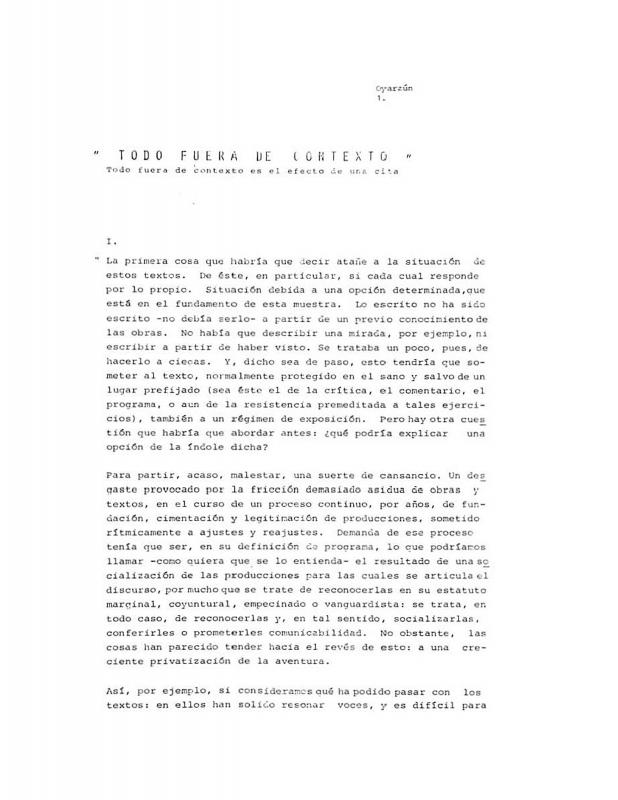The Fuera de serie exhibition was presented at the Galería Sur in Santiago, Chile, in September 1985. Participating artists were as follows: Francisco Brugnoli (b. 1935), Juan Domingo Dávila (b. 1946), Gonzalo Díaz (b. 1947), Eugenio Dittborn (b. 1943), Arturo Duclos (b. 1959), Virginia Errázuriz (b. 1941), and Carlos Leppe (1952–2015). The catalogue included this text by Nelly Richard (b. 1948), one by the writer Gonzalo Muñoz (b. 1956), and another by Pablo Oyarzún (b. 1950). [See the following in the ICAA Digital Archive: “Todo fuera de contexto: todo fuera de contexto es el efecto de una cita” (doc. no. 734699)].
The theorist Guillermo Machuca (1962–2020) claimed that, for some in the art field, Fuera de serie was the end of the Escena de Avanzada, the name that Richard coined to refer to experimental approaches that went beyond the traditional boundaries of Chilean art. Furthermore, prior to this event, the Museo Nacional de Bellas Artes presented the international exhibition Rauschenberg Overseas Cultural Interchange (July–August 1985). This prompted a reaction in art circles that was reflected in the catalogue text by Oyarzún, which analyzed the effects of the exhibition, and in Pintura por encargo (1985), one of the works in the exhibition by Gonzalo Díaz that was comprised of two pieces: The first one consisted of a movie poster commissioned from a well-known painter who specialized in that genre. The second showed the artist (in black and white) standing in front of the painting. The poster’s headline was a tongue-in-cheek reference to the title of the Rauschenberg exhibition: “PROXIMO CAPITULO DE LA PINTURA CHILENA/LADIAZ SOBRELOSMARES INTERCAMBIO KULTURAL” (sic) (The Next Chapter of Chilean Painting/LaDiaz Overseas Kultural Interchange [sic]).
In "Intertexto," Richard pays particular attention to local conditions and to quotes at two different levels. She uses them, first of all, in support of her analysis and, secondly, she looks at how quotes are used in the works on display at the exhibition. The use of quotes allows Richard to present the context of the exhibition and offers a way to respond to it at a local level. One of the first texts she quotes is Oyarzún’s comment about the painter Adolfo Couve (1940–1998), who had been writing about art since 1973, but did not paint again until 1984. Richard then quotes from an article in APSI magazine, by the culture journalist Claudia Donoso (b. 1955), about Seis +, the exhibition of works by six young women artists at the Galería Época (Santiago, July 1985). The third quote is from Justo Pastor Mellado’s essay in the catalogue for Cuatro artistas chilenos en el CAYC de Buenos Aires, an exhibition that took place some months earlier and included three of the four artists who participated in Fuera de serie. The final quote Richard uses is from an article by the artist Francisco Brugnoli that appeared in the Boletín no. 1, published by the Asociación de Pintores y Escultores de Chile (APECH). In his article, Brugnoli discusses what the younger generations of artists are doing based on their academic university training. Richard assembles these quotes to present a summary of the Chilean art scene in 1985, twelve years after the military coup d’état.

